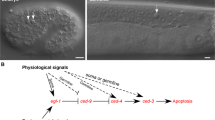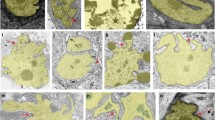Abstract
Apoptosis, or programmed cell death (PCD), is a naturally occurring process of cell suicide that plays a critical role in the development and maintenance of multicellular organisms. It is required for sculpting tissue architecture, for the development of the nervous and immune systems, as a defense against viral pathogens and protection from cancer1–11. Apoptosis is characterized by cellular shrinkage, nuclear condensation, membrane blebbing and fragmentation of the cell into membrane-enclosed vesicles called apoptotic bodies. The apoptotic bodies are rapidly phagocytosed by neighboring cells and macrophages without the release of cytoplasmic contents. This avoids inflammation and autoimmunization with intracellular constituents. Despite the biological importance of apoptosis, its molecular and biochemical basis remains obscure. The most important information about components of the death pathway comes from the study of the nematode worm Caenorhabditis elegans 12–14. The complete cellular lineage of the hermaphrodite form of C. elegans has been established. Of the 1,090 cells generated during development, 131 die by a cell-intrinsic death program. Genetic analysis has identified 14 genes that function in different steps of PCD in C. elegans. Two genes, ced-3 and ced-4, are required for these developmental deaths. If either is inactivated, none of the 131 cells die7. The ced-9 gene antagonizes the function of ced-3 and ced-4 by protecting cells from death7. In ced-9 loss-of-function mutants, cells that normally live undergo PCD early in development, resulting in embryonic lethality. Thus, ced-9 is necessary for the survival of most cells and presumably ced-9 accomplishes this by suppressing the cell death program7. Several recent discoveries have shed light on the function of the C. elegans cell-death genes and, more importantly, have shown that they have mammalian counterparts with similar functions. The machinery controlling cell viability and cell death appears to be highly conserved through evolution and is briefly reviewed below.
Access this chapter
Tax calculation will be finalised at checkout
Purchases are for personal use only
Preview
Unable to display preview. Download preview PDF.
Similar content being viewed by others
References
M.C. Raff, Social controls on cell survival and cell death. Nature 356: 397–400 (1992).
C.B.Thompson, Apoptosis in the Pathogenesis and Treatment of Disease. Science 267: 1456–1462 (1995).
J.J. Cohen, Apoptosis. Immunology Today 14: 126–130 (1993).
G. Majno, and I.Joris, Apoptosis, Oncosis, and Necrosis. American Journal of Pathology 146: 3–15 (1995).
M.C. Peitsch, H.G. Mannherz, and J. Tschopp, The apoptosis endonucleases: cleaning up after cell death? Trends in Cell Biology 4: 37–41 (1994).
D.L. Vaux, G. Haecker, and A. Strasser, An Evolutionary Perspective on Apoptosis. Cell 76: 777–779 (1994).
M.O. Hengartner, Programmed cell death in invertebrates. Current Opinion in Genetics and Development 6: 34–38 (1996).
G.I. Evan, L. Brown, M. Whyte, and E. Harrington, Apoptosis and cell cycle. Current Opinion in Cell Biology 7: 825–836 (1995).
E. White, Life, death, and the pursuit of apoptosis. Genes and Development 10: 1–15 (1996).
S.J. Martin, and D.R. Green, Protease activation during apoptosis: death by a thousand cuts? Cell 82: 349–352 (1995).
S. Kumar, and N.L. Harvey, Role of multiple cellular proteases in the execution of programmed cell death. FEBSLetters 375: 169–173 (1995).
H.M. Ellis, and H.R. Horvitz, Genetic control of programmed cell death in the nematode Caenorhabditis elegans. Ce1144: 817–829 (1986).
J.Y. Yuan, and H.R. Horvitz, The Caenorhabditis elegans genes ced-3 and ced-4 act cell autonomously to cause programmed cell death. Dev Biol 138: 33–41 (1990).
J. Yuan, S. Shaham, S. Ledoux, H.M. Ellis, and H.R. Horvitz, The C. elegans cell death gene ced-3 encodes a protein similar to mammalian Interleukin-lß-Converting Enzyme. Cell 75: 641–652 (1993).
J.C. Reed, Bc1–2 and the Regulation of Programmed Cell Death. J Cell Biol 124: 1–6 (1994).
G. Nunez, and M.F. Clarke, The bc1–2 family of proteins: regulators of cell death and survival. Trends in Cell Biology 4: 399–403 (1994).
M.O. Hengartner, R.E. Ellis, and H.R. Horvitz, Caenorhabditis elegans gene ced-9 protects cells from programmed cell death. Nature 356: 494–9 (1992).
N.A. Thornberry, H.G. Bull, J.R. Calaycay, K.T. Chapman, A.D. Howard, M.J. Kostura, et al., A novel heterodimeric cysteine protease is required for interleukin-lß processing in monocytes. Nature 356: 768–774 (1992).
M. Miura, H, Zhu, R. Rotello, E.A. Hartwieg, and J. Yuan, Induction of Apoptosis in Fibroblasts by IL-10 Converting Enzyme, a Mammalian Homolog of the C. elegans Cell Death Gene ced-3. Cell 75: 653–660 (1993).
P. Li, H. Allen, S. Banerjee, S. Franklin, L. Herzog, C. Johnston C, et al.: Mice deficient in IL-Iß-converting enzyme are defective in production of mature IL-10 and resistant to endotoxic shock. Cell 80: 401–411 (1995).
S. Kumar, M. Kinoshita, M. Noda, N.G. Copeland, and N.A. Jenkins, Induction of apoptosis by the mouse Nedd2 gene, which encodes a protein similar to the product of the Caenorhabditis elegans cell death gene ced-3 and the mammalian IL-lß-converting enzyme. Genes and Development 8: 1613–1626 (1994).
L. Wang, M. Miura, L. Bergeron, H. Zhu, and J. Yuan, Ich-1, an ICE/ced-3-related gene, encodes both positive and negative regulators of programmed cell death. Cell 78: 739–750 (1994).
M. Tewari, L.T. Quan, K. O’Rourke, S. Desnoyers, Z. Zeng, D.R. Beidler, et al., Yama/CPP32ß, a mammalian homolog of CED-3, is a CrmA-inhibitable protease that cleaves the death substrate poly(ADP-ribose) polymerase. Cell 81: 801–809 (1995).
T. Fernandes-Alnemri, G. Litwack, E.S. and E.S. Alnemri, CPP32, a novel human apoptotic protein with homology to Caenorhabditis elegans cell death protein Ced-3 and mammalian interleukin-1 ß-converting enzyme. JBiol Chem 269: 30761–30764 (1994).
D.W. Nicholson, A.AIi, N.A. Thornberry, J.P. Vaillancourt, C.K. Ding, M. Gallant, et al., Identification and inhibition of the ICE/CED-3 protease necessary for mammalian apoptosis. Nature 376: 37–43 (1995).
N.A. Munday, J.P. Vaillancourt, A. Ali, F.J. Casano, D.K. Miller, S.M. Molineaux, et al., Molecular cloning and pro-apoptotic activity of ICErel II and ICEreI III, members of the ICE/CED-3 family of cysteine proteases. JBiol Chem 270: 15870–6 (1995).
C. Faucheu, A. Diu, A.W. Chan, A.M. Blanchet, C. Miossec, F. Herve, et al.: A novel human protease similar to the interleukin-1 beta converting enzyme induces apoptosis in transfected cells. Embo J 14: 1914–22 (1995).
J. Kamens, M. Paskind, M. Hugunin, R.V. Talanian, H. Allen, D. Banach, et al.: Identification and characterization of ICH-2, a novel member of the interleukin-1 beta-converting enzyme family of cysteine proteases. JBiol Chem 270: 15250–6 (1995).
T. Fernandes-Alnemri, G. Litwack, and E.S. Alnemri, Mch2, a new member of the apoptotic Ced-3/Ice cysteine protease gene family. Cancer Res 55: 2737–42 (1995).
H. Duan, A.M. Chinnaiyan, P.L. Hudson, J.P. Wing, W. He, and V.M. Dixit, ICE-LAP3, a Novel Mammalian Homolog of the Caenorhabditis elegans Cell Death Protein CED-3 is Activated During Fas-and Tumor Necrosis Factor-Induced Apoptosis. J Biol Chem 271: 35013–35 (1996).
T. Fernandes-Alnemri, A. Takahashi, R. Armstrong, J. Krebs, L. Fritz, K.J. Tomaselli, et al.: Mch3, a Novel Human Apoptotic Cysteine Protease Highly Related to CPP32. Cancer Res 55: 6045–6052 (1995).
J.A. Lippke, Y. Gu, C. Sarnecki, P.R. Caron, M.S.-S. Su, Identification and characterization of CPP32/Mch2 homolog 1, a novel cysteine protease similar to CPP32. J Biol Chem 271: 1825–1828 (1996).
A.M. Chinnaiyan, K. Orth, K. O’Rourke, H. Duan, G.G. Poirier, and V.M. Dixit, Molecular ordering of the cell death pathway: bc1–2 and bcl-xL function upstream of the CED-3-like apoptotic proteases. J Biol Chem 271: 4573–4576 (1996).
J. Schlegel, I. Peters, S. Orrenius, D.K. Miller, N.A. Thornberry, T.-T. Yamin, et al., CPP32/Apopain is the key interleukin-lf3 converting enzyme-like protease involved in Fas-mediated apoptosis. J Biol Chem 271: 1841–1844 (1996).
Z.-Q. Wang, B. Auer, L. Stingl, H. Berghammer, D. Haidacher, M. Schweiger M, et al.: Mice lacking ADPRT and poly(ADP-ribosyl)ation develop normally but are susceptible to skin disease. Genes and Dey 9: 509–520 (1995).
Y.A. Lazebnik, A. Takahashi, R. Moir, R. Goldman, G.G. Poirier, S.H. Kaufmann, et al.: Studies of the lamffn proteinase reveal multiple parallel biochemical pathways during apoptotic execution. Proc Natl Acad of Sci USA 92: 9042–9046 (1995).
N. Neamati, A. Fernandez, S. Wright, J. Kiefer, and D.J. McConkey, Degradation of lamffn B1 precedes oligonucleosomal DNA fragmentation in apoptotic thymocytes and isolated thymocyte nuclei.Jlmrounol 154: 1693–1700 (1994).
M. Tewari, D.R. Beidler, and V.M. Dixit, CrmA-inhibitable cleavage of the 70 kDa protein component of the Ul small nuclear ribonucleoprotein during Fas-and tumor necrosis factor-induced apoptosis. J. Biol. Chem. 270: 18738–18741 (1995).
L.A. Casciola-Rosen, D.K. Miller, G.J. Anhalt, and A. Rosen, Specific cleavage of the 70-kDa protein component of small nuclear ribonucleoprotein is a characteristic biochemical feature of apoptotic cell death. J. Biol. Chem. 269: 30757–30760 (1994).
S. Na, R.H. Chuang, T.G. Turi, J.H. Hanke, G.M. Bokoch, and D.E. Danley, D4-GDI, a substrate for CPP32, is proteolyzed during Fas-induced apoptosis. JBiol Chem In Press (1996).
X. Wang, N.G. Zelenski, J. Yang, J. Sakai, M.S. Brown, and J.L. Goldstein, Cleavage of the sterol regulatory element binding proteins (SREBPs) by CPP32 during apoptosis. EMBO J 15: (1996)
Y. Emoto, Y. Manome, G. Meinhardt, T. Ghayur, W.W. Wong, R. Kamen, et al., Proteolytic activation of protein kinase C S an ICE-like protease in apoptotic cells. EMBO J 14: 6148–6156 (1995).
M.D. Jacobson, J.F. Burne, and M.C. Raff, Programmed cell death and Bc1–2 protection in the absence of a nucleus. EMBO J 13: 1899–910 (1994).
K. Schulze-Osthoff, H. Walczak, W. Droge, and P.H. Krammer, Cell Nucleus and DNA Fragmentation are not Required for Apoptosis. J Cell Biol 127: 15–20 (1994).
Author information
Authors and Affiliations
Editor information
Editors and Affiliations
Rights and permissions
Copyright information
© 1996 Springer Science+Business Media New York
About this chapter
Cite this chapter
Dixit, V.M. (1996). Role of Ice-Proteases in Apoptosis. In: Gupta, S., Cohen, J.J. (eds) Mechanisms of Lymphocyte Activation and Immune Regulation VI. Advances in Experimental Medicine and Biology, vol 406. Springer, Boston, MA. https://doi.org/10.1007/978-1-4899-0274-0_11
Download citation
DOI: https://doi.org/10.1007/978-1-4899-0274-0_11
Publisher Name: Springer, Boston, MA
Print ISBN: 978-1-4899-0276-4
Online ISBN: 978-1-4899-0274-0
eBook Packages: Springer Book Archive




